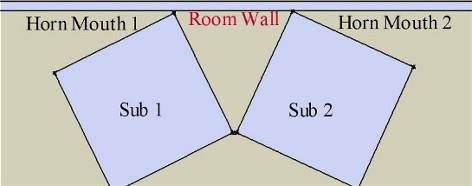Rich4349 wrote: ↑Tue Nov 19, 2024 11:05 am
This is probably a boneheaded suggestion, but could a small width sub of the same design be placed in the restaurant, out of phase to the primary subs?
Since the other room isn't the primary conversation point, I won't go down that rabbit hole. But briefly, yes there are situations where strategic placement and time/phase manipulation can be used to create intentional null zones. I'm nowhere near knowledgeable enough in the subject to speak to it with any sort of authority. That would be a learning conversation for me and would really demand it's own dedicated thread.
Camillo wrote: ↑Mon Nov 18, 2024 5:51 pm
Ah I see. Do you have any "dont's" for when I'm testing locations?
Don't place the cabs in the no-go zone.

The no-go zone is a distance from a wall that is greater than a quarter wavelength of the highest frequency the cab's intended to create and less than a quarter wavelength of the lowest frequency.
To calculate those distances, divide the speed of sound in feet (or meters) per second by the frequency to get the wavelength. Multiply by 0.25 (or divide by 4) to get a quarter wavelength. The speed of sound varies with temperature, but I always use 1125fps in my calculations (343 meters per second)
So, for a bandwidth of 40Hz to 100Hz, the no-go zone is between 86cm and 214cm (2' 10" and 7') from a wall.
If you place the cab with the mouth in the no-go zone, the reflected soundwave will produce a deep cancellation centered on the frequency at which a quarter wavelength corresponds to the measured distance. "Centered" means that's the frequency the cancellation will be greatest. The cancellation will also effect frequencies surrounding the center cancellation frequency to a diminishing degree the further out a frequency is from the center frequency.
Best practice is to place the cab with the mouth aimed into a corner or angle loaded against a wall whenever possible.
You may also try putting the cabs together and angle loaded in the center of wall "D". I know it doesn't make sense to the eyes, but let your ears and measurement microphones determine the optimum position and placement. If I put a blindfold on you then guided you to stand where a huge stack of subwoofers were a meter away from you, immediately to your left, yet placed the mains in front of you and asked you to point to the subwoofers... if the subwoofers are playing cleanly without any distortion, even though you could literally raise your left arm and touch them, you won't be able to point to them. You'd most likely point in the direction of the mains, which is the only location your brain can possibly associate the frequency location... unless you already knew this, in which case you'd point elsewhere in hopes a random lucky guess could could look like you broke the laws of physics in relation to human physiology. LOL
Really truly though, try them on that wall in this configuration:

Here's a sticky thread if you haven't already seen it,
Rules for Subwoofer placement and stacking.
